|
|
Dell Latitude 12 Rugged Tablet
A year with Dell's tough and rugged 12-inch tablet
(by Conrad H. Blickenstorfer)
Dell initially introduced the Latitude 12 Rugged Tablet in mid-2015. It is a tough and well-protected Windows tablet computer, and complements Dell's other rugged mobile computing offerings. As such, the rugged Dell tablet joined the Dell 14 Rugged and Rugged Extreme laptops and the Dell 12 Rugged Extreme convertible notebook. RuggedPCReview has had a long-term loaner over the past year, and this review describes the Dell Rugged Tablet in detail.
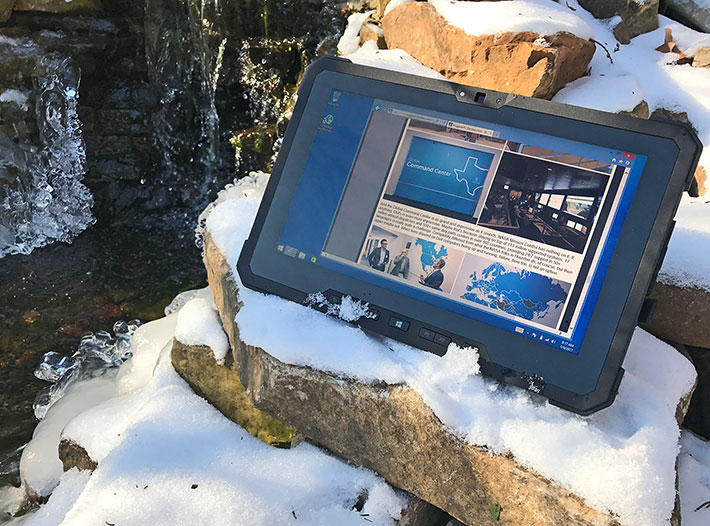
First, why did Dell add a rugged tablet to its lineup of tough laptops and convertibles? The obvious reason is Dell's resolve to step up its presence in the rugged PC market where the company has highly competitive product offerings on the notebook side but didn't have anything in the faster growing rugged tablet and detachable 2-in-1 sector.
Why do I mention detachable and 2-in-1 right upfront? Because the Dell Rugged Tablet has one of the best — and best integrated — keyboards available for any tablet. It's an option and rather pricey (US$372 for the keyboard and kickstand), but it's so good that we consider it pretty much mandatory. This is not one of those awful cardboard-thin keyboard covers that are almost unusable. This one works.
It is a full-scale, fully functional, heavy-duty keyboard that magnetically snaps onto the tablet with authority. The accompanying kickstand, likewise, is brilliant. It's small and light and never gets in the way, but it makes for a stable 2-in-1 combo that is not in danger of toppling over like many other detachable keyboard solutions. The picture sequence below shows the Dell Rugged Tablet with its optional keyboard and kickstand:
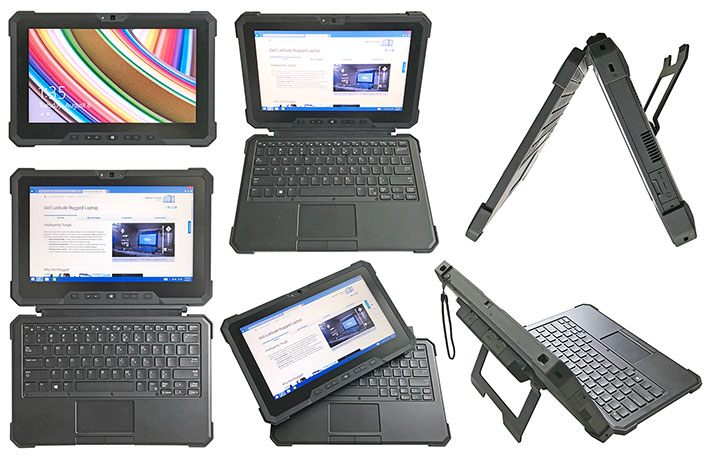
For a brief overview of the Dell Rugged Tablet itself: It has a satisfyingly large 11.6-inch display with capacitive multi-touch. Its 12.3 x 8.0 inch footprint is roughly that of the 12.9-inch iPad Pro. As a rugged Windows device with plenty of standard ports, the Dell is, of course, considerably thicker and heavier than the iPad. About an inch thick, and starting at a not inconsiderable 3.6 pounds. The Dell tablet is powered by a choice of super-efficient Intel 5th generation Core M processors. Pricing starts at US$1,849 (as of mid August 2017), but nicely equipped we're talking a grand more. So this is a fairly high-end product.
How the Dell 12 Rugged Tablet compares to the Dell 12 Rugged Extreme
Anyone contemplating the Dell Rugged Tablet will likely wonder how the tablet differs from Dell's Latitude 12 Rugged Extreme convertible (shown in the picture to the right).
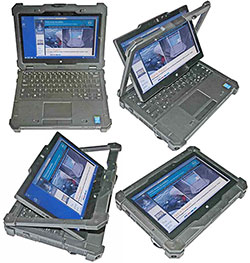 Both have 11.6-inch screens, both can be used either as laptops or as tablets, both have roughly the same battery power, and both have fairly comprehensive onboard connectivity. Both have 11.6-inch screens, both can be used either as laptops or as tablets, both have roughly the same battery power, and both have fairly comprehensive onboard connectivity.
The answer is that the 12 Rugged Tablet is first and foremost a tablet, and the 12 Rugged Extreme is first and foremost a true laptop. Without its optional detachable keyboard, the tablet is light enough to go anywhere, whereas the 12 Rugged Extreme's convertible keyboard is permanently attached so that the device still weighs a full six pounds when used as a tablet. That's a big weight difference.
There is also a considerable difference in performance between the two. The tablet was designed to be used in the field, so emphasis was on best possible battery life. That's accomplished via the use of the Core M processors that mostly run at a low clock speed, although they are capable of short performance bursts. The convertible is more likely to be used in vehicles or on desks, so emphasis is on high performance. And that comes via Core i3, i5, or i7 processors running at much higher clock speeds.
Finally, there's a difference in overall ruggedness. The convertible is a fully rugged device, whereas the tablet uses somewhat lighter construction.
But doesn't Dell deal in high-volume PCs with short life cycles?
And that's another question almost anyone considering Dell's rugged tablet (or rugged laptops). Doesn't Dell specialize in very high volume desktops and laptops that are constantly upgraded, changed and replaced? They do, and that's a good thing for consumers and enterprises that always want the latest and greatest technology.
In fact, when Dell initially announced its entry into the rugged laptop market in earnest (the company had been selling rugged laptops made by Augmentix for a number of years, before taking Augmentix inhouse)  we thought that Dell's ready access to the latest technology and inherent capability to make that technology quickly available to customers would be their major selling point in rugged systems as well. But we also wondered how Dell was going to do that, as vertical, governmental and industrial markets have much longer product life cycles, and they also rely on equipment remaining compatible with a large and costly infrastructure in mounting equipment, accessories, and assorted other complementary gear. we thought that Dell's ready access to the latest technology and inherent capability to make that technology quickly available to customers would be their major selling point in rugged systems as well. But we also wondered how Dell was going to do that, as vertical, governmental and industrial markets have much longer product life cycles, and they also rely on equipment remaining compatible with a large and costly infrastructure in mounting equipment, accessories, and assorted other complementary gear.
As it turned out, Dell is very aware of those differences between consumer/enterprise and vertical markets. And since the beginning of Dell's entry into the rugged computing market, Dell rugged products have actually been among the most stable and obsolescence-proof computing platforms available today. Dell pays meticulous attention to legacy support, interchangeability of gear and accessories, and the needs and requirements of rugged markets in general.
That's not to say that Dell lets its rugged products fall behind when compared to the rapid new product introduction pace on the consumer/enterprise side of the business. In fact, Dell's laptops and convertible have all received substantial tech updates, but Dell generally does that without much fanfare and without any change in appearance or compatibility. The tablet, which was introduced after the laptops and convertible, will doubtlessly follow suit.
Latitude 12 Rugged Tablet — design, look, and feel
All of Dell's Rugged and Rugged Extreme laptops and tablets are part of the company's Latitude line of business laptops. On the Dell website's Latitude page they are designated the "Rugged Series," and there's also a special Dell Latitude Rugged Laptop section.
This does not, however, mean that Dell's rugged laptop and tablets are simply heavier duty and better protected versions of standard Dell Latitude products. Instead, while the rugged products may share certain components and technologies from certain models in the Latitude lineup, they are unique and separate designs from the ground up. While "civilian" business Latitudes sport a sleek, elegant contemporary consumer/business laptop look, the rugged models use an entirely different design language.
As is, Dell has done a good job in visually differentiating their rugged offerings from more civilian and enterprise platforms, all the while creating a sharp, purposeful and quite elegant look. It's a look that's not as overtly utilitarian as some rugged computing gear; Dell went more for an elegant, high quality look. The tablet feels tough, solid and substantial, and there's never a doubt that this is a much heavier-duty computing machine than any standard consumer or even business tablet.
Dell's using just one color here, black. The housing is black reinforced polycarbonate plastic, with the front bezel and sides having a matte, rubberized finish. There are protective corner bumpers that are nicely integrated into the overall design. Since the tablet has a capacitive touch screen, the front glass extends flush well beyond the actual LCD perimeter, just as it should for easiest touch operation. And the actual housing bezel surrounding the glass slightly angles up, so as to provide extra protection to the screen without having your fingers bump into it. The glass surface itself is glossy but in a heavily muted way.
But let's take a closer look at the Dell Latitude 12 Rugged Tablet. Below you can see the top and all four sides of the machine, with the side views also showing the attached optional keyboard:
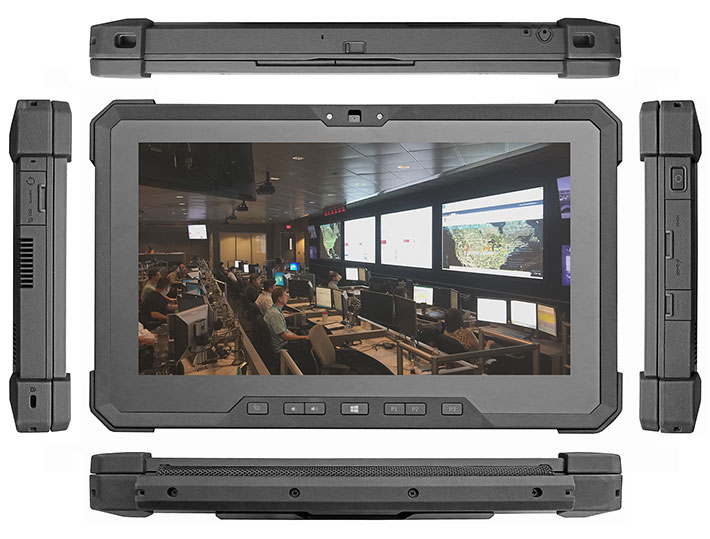
Below the display, which is clearly designed to be used in landscape orientation, are seven physical buttons. Their labels are very legible. The front camera is in the center where it belongs, and it has a manual shutter.
Ports and connectivity are on the left and right side of the tablet. To guard against physical damage, all ports are located behind protective doors that snap into place. The two pictures below show the left (top) and right (bottom) side of the unit with all protective doors in the open position.
On the left side, from left to right and protected by a single plug, are an audio in/out jack, a Micro HDMI port, and a Micro SD Card slot. Next to that are the cooling vents 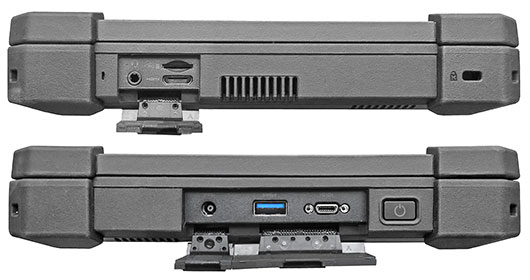 for the very non-intrusive fan that is barely audible when it comes on. Note that the visible vents do not let liquids get inside the computer. for the very non-intrusive fan that is barely audible when it comes on. Note that the visible vents do not let liquids get inside the computer.
The fan chamber is sealed towards the actual interior of the housing. And the fan can handle water. Next to the fan vent is a physical lock slot.
On the right side, from left to right, there is the small illuminated power button, then a protective door with a micro serial port and a standard USB 3.0 port. Next to that is the power jack.
Below is a look at the backside of the 12 Rugged Tablet with one of the available modular expansions bolted on. Shown is the Extended I/O Module with two additional USB 3.0 ports as well as an RJ45 LAN jack. Also visible are the stylus garage and stylus lanyard anchor loop, as well as a smart card reader slot. When not in use, the slot can be plugged with a dummy insert that's not so dummy at all; it also serves as a handy 2-inch/5 centimeter ruler, shows the morse code for SOS and HELP, and shows how to figure out North. Where else do you get that!

Overall, the design of the Dell Rugged Tablet impresses on all fronts. While not insubstantial, this is an elegant, practical, functional solution that looks and feels just right.
Capacitive multi-touch — works with gloves
The Dell Latitude 12 Rugged Tablet, like virtually every other modern tablet, offers 10-point capacitive multi-touch. Tapping, panning, swiping, pinching and zooming work smoothly and effortlessly with none of the slight delay that used to mar touch on Windows hardware.
Interestingly, touch is one area where the tablet differs from Dell's convertible that uses 5-point resistive multi-touch. When we reviewed the convertible, we assumed Dell had gone with resistive multi-touch because early capacitive touch screens couldn't handle gloves or rain. The resistive digitizer of the convertible indeed handled both gloves and operation in the rain very well.
As is, the capacitive touch screen of the Rugged Tablet also handles gloves quite well. And while the convertible's display surface had a bit more stiction than we liked, the tablet display surface is as smooth as we've come to expect from capacitive touch technology.
 The tablet comes with a very nice 4-1/4 inch capacitive stylus with a narrow 3mm hard rubber tip. The stylus works much better than the thick, soft rubber tips so often used in lesser tablets. When not in use, the stylus, which has an almost foot-long spiral tether cord, can be parked in a special garage on top of the tablet. The tablet comes with a very nice 4-1/4 inch capacitive stylus with a narrow 3mm hard rubber tip. The stylus works much better than the thick, soft rubber tips so often used in lesser tablets. When not in use, the stylus, which has an almost foot-long spiral tether cord, can be parked in a special garage on top of the tablet.
In our year-long use of the Dell Rugged Tablet, we almost always took the detachable keyboard with us when on the road. It snaps on so easily and so securely that it's like having a laptop. Touch was precise enough for most tablet operations, though we also often used the stylus. On the desktop we often used the device as a laptop. Having a personal preference of mice over touchpads, we used a small generic bluetooth mouse with it.
Performance: Thrifty Intel Core-M processor technology
On the processor side of things, Dell decided to go with the choice of two CPUs from Intel's Core-M lineup. Core-M was specifically developed for fanless tablets where silent operation, a thin profile, and low weight matter.
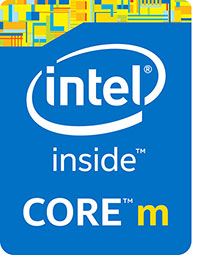 What is Core-M and how is it different from Intel's regular Core processors? Here's the story: Pressured to come up with chips that could power Windows but still work within the constraints of slender consumer tablets, Intel decided to design chips that were precisely matched to the heat dissipation capacity of various sizes of tablets with metal chassis. Using this approach, a super-thin 10.1-inch tablet, Intel determined, could dissipate the heat generated by a processor with a thermal design power of 3 watts, whereas a thicker 12.5-inch tablet comfortably remove the heat of a 5 watt chip. What is Core-M and how is it different from Intel's regular Core processors? Here's the story: Pressured to come up with chips that could power Windows but still work within the constraints of slender consumer tablets, Intel decided to design chips that were precisely matched to the heat dissipation capacity of various sizes of tablets with metal chassis. Using this approach, a super-thin 10.1-inch tablet, Intel determined, could dissipate the heat generated by a processor with a thermal design power of 3 watts, whereas a thicker 12.5-inch tablet comfortably remove the heat of a 5 watt chip.
What does "comfortably" mean in this context? It means that given an ambient temperature of 77°F, the heat generated by the processor should not increase the outside surface of the tablet to more than 106°F. It'd be interesting to know more about the train of thought that led Intel to this approach, but that's the way it is.
Even Intel, though, could not create a special processor for every conceivable tablet size and thickness. Instead, Intel allows for "configurable" performance (and thus heat dissipation) via "TDP-up" and "TDP-down" settings, i.e. the allowable maximum heat generated by the processor can be adjusted by tablet manufacturers. That's primarily accomplished through varying the base clock speeds and invoking of power states. This means that the same exact chip can be faster or slower depending on the heat removal capabilities of the device it's used in.
|
Dell Rugged Tablet CPUs
|
|
|
|
Intel
|
Core 5th gen M
|
Core 5th gen M
|
|
Codename
|
Broadwell-Y
|
Broadwell-Y
|
|
Model
|
5Y71
|
5Y10c
|
|
Cores/Threads
|
2/4
|
2/4
|
|
Lithography
|
14mn
|
14mn
|
|
Base Clock Speed
|
1.20 GHz
|
0.80 GHz
|
|
Turbo Speed
|
2.90 GHz
|
2.00 GHz
|
|
Thermal Design Power (TDP)
|
4.5 watts
|
4.5 watts
|
|
Smart Cache
|
4MB
|
4MB
|
|
Integrated graphics
|
HD Graphics 5300
|
HD Graphics 5300
|
|
Graphics base speed
|
300 MHz
|
300 MHz
|
|
Graphics max speed
|
900 MHz
|
800 MHz
|
|
Intel vPro
|
Yes
|
No
|
|
Intel TSX-NI
|
Yes
|
No
|
|
Intel SIPP
|
Yes
|
No
|
|
Intel Trusted Execution
|
Yes
|
No
|
What does all that mean in less technical terms? Let's take an automotive analogies to explain that.
Once upon a time, muscle cars (and most other American sedans) had big, thirsty powerful V8 engines. That worked great as long as gas was cheap and weight and emissions didn't matter. Once gas mileage and air pollution became issues, the auto industry looked for smaller, cleaner and more efficient solutions. That was a formidable technological challenge.
Over time, technology advanced to an extent where small turbocharged 4-cylinder engines can now produce V8-level power and 4-cylinder economy. These small new engines are very sophisticated (and can be quite expensive). This is exactly what Intel did with their Core-M processors. They are like small and economical 4-cylinder engines that get great gas mileage but can also generate impressive performance when the turbo kicks in.
So for their rugged tablet tablets, Dell offers the choice of two Core-M chips, the M-5Y71 and the M-5Y10c. Both are part of Intel's 5th generation of Core processors, here codenamed "Broadwell-Y." These are the same chips Dell, Lenovo, Apple and others used in a variety of high-end products. The table to the left shows the major specs of the two processors.
But what about the difference between the two available processors for the Dell Rugged Tablet? Easy. The "low-end" M-5Y10 is the modestly turbo-charged engine designed for reliable tooling around town all day long. The "high-end" M-5Y71 is the hot econohatch that can make insane power at the track, but only in short bursts before it must cool down. Back in the day such hot rod turbo motors tended to quickly self-destruct, but today's sophisticated engine computers keep track of everything and completely control power to keep things safe.
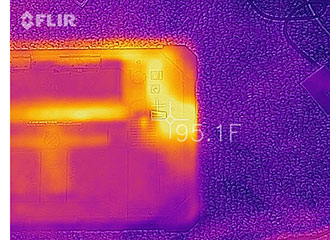 That's exactly how it works with these two Core-M chips. They are really not "low-end" and "high-end" (Intel actually charges the exact same for both chips). Instead, the M-5Y10 chip option, with its lower base speed and capped maximum turbo speed, is best for applications in temperature-controlled environments with continuous, predictable workloads. It's a little slower, but its performance is very predictable because it rarely heats up enough for the chip to throttle back performance to cool down. That's exactly how it works with these two Core-M chips. They are really not "low-end" and "high-end" (Intel actually charges the exact same for both chips). Instead, the M-5Y10 chip option, with its lower base speed and capped maximum turbo speed, is best for applications in temperature-controlled environments with continuous, predictable workloads. It's a little slower, but its performance is very predictable because it rarely heats up enough for the chip to throttle back performance to cool down.
The M-5Y71, on the other hand, thrives in on-again, off-again settings where it may be called upon to handle complex, processor-intensive tasks with very high peak performance, then idle along until the next engagement. If the former sounds like suited for work environments with routine schedules, and the latter for unpredictable work out there in the field where you never know what to expect, THAT is likely why Dell chose those two options. The infrared picture to the right shows the Dell Rugged Tablet running benchmarks in an office with ambient 77F; the tablet surface never got hotter than 95 degrees.
In order to get a sense of the Dell Rugged Tablet's performance, we installed Passmark Software's PerformanceTest 6.1 that runs about 30 tests covering CPU, 2D graphics, 3D graphics, memory, and disk and then computes scores for each category and an overall PassMark score. We also ran our second benchmark suite, CrystalMark, which concentrates on single core performance. For comparison, we added the results of Dell's original Latitude 12 Rugged Extreme and Latitude 14 Rugged Extreme. We also added results of two of the Dell tablet's competitors in the 11.6-inch rugged tablet class, the GammaTech R11 and the Getac F110 tablet.
|
Dell Latitude 12 Rugged Extreme Benchmarks and Comparisons
|
|
PERFORMANCE COMPARISON
|
Dell
|
Dell
|
Dell
|
GammaTech
|
Getac
|
|
Model
|
12 Rugged Tablet
|
12 Rugged Extreme
|
14 Rugged Extreme
|
R11
|
F110
|
|
Type
|
Tablet/2-in-1
|
Convertible
|
Standard laptop
|
Tablet
|
Tablet
|
|
Year tested
|
2017
|
2015
|
2015
|
2016
|
2015
|
|
Display
|
11.6" 1366 x 768
|
11.6" 1366 x 768
|
14.0" 1366 x 768
|
11.6" 1366 x 768
|
11.6" 1366 x 768
|
|
Processor Type: Intel
|
Core M
|
Core i5
|
Core i5
|
Core i5
|
Core i7
|
|
Processor Model
|
5Y71
|
4300U
|
4300U
|
5200U
|
5500U
|
|
CPU Speed
|
1.20GHz
|
1.90GHz
|
1.90GHz
|
2.20GHz
|
2.40GHz
|
|
Turbo Speed
|
2.90GHz
|
2.90GHz
|
2.90GHz
|
2.70GHz
|
3.00GHz
|
|
Thermal Design Power (TDP)
|
4.5 watts
|
15 watts
|
15 watts
|
15 watts
|
15 watts
|
|
BatteryMon minimal draw
|
3.3 watts
|
4.1 watts
|
6.5 watts
|
NA
|
NA
|
|
CPU Mark
|
2,683.8
|
3,542.6
|
3,522.0
|
3,545.6
|
3,864.1
|
|
2D Graphics Mark
|
370.6
|
498.7
|
474.7
|
423.7
|
514.7
|
|
Memory Mark
|
952.2
|
1,183.7
|
1,144.1
|
1,052.3
|
1,215.6
|
|
Disk Mark
|
3,595.2
|
3,793.9
|
3,984.6
|
3,901.1
|
3,790.4
|
|
3D Graphics Mark
|
265.6
|
485.0
|
484.3
|
337.1
|
399.1
|
|
Overall PassMark
|
1,694.0
|
2,056.4
|
2,078.4
|
2,026.7
|
2,140.1
|
|
ALU
|
32,389
|
42,712
|
42,120
|
41,063
|
45,208
|
|
FPU
|
26,550
|
41,847
|
39,941
|
40,731
|
41,610
|
|
MEM
|
29,070
|
43,795
|
43,971
|
29,692
|
30,389
|
|
HDD
|
38,565
|
40,714
|
42,880
|
39,300
|
41,405
|
|
GDI
|
11,673
|
16,109
|
16,050
|
13,452
|
16,218
|
|
D2D
|
4,373
|
7,790
|
14,219
|
5,710
|
6,438
|
|
OGL
|
6,843
|
12,884
|
32,989
|
11,210
|
10,543
|
|
Overall CrystalMark
|
149,463
|
182,991
|
265,146
|
188,921
|
191,811
|
Right upfront, note that the results in the above table should not be construed as an absolute comparison which product is fastest. Each of the listed devices comes with several processor options, and three of the five products have been upgraded since we last benchmarked them in the RuggedPCReview.com testing lab. So view the numbers as what sort of performance can be expected from different types of processors and processor generations, clock speeds, and thermal design powers.
Note that there's remarkable parity between the four listed Core processor devices. Even though the quartet uses both 4th and 5th generation Core processors, i5 and i7 versions, and different standard and turbo clock speeds, overall benchmark performance doesn't vary much. The sole exception is Dell's big 14 Rugged Extreme laptop that came with an optional discrete graphics module that greatly boosted video performance in certain benchmark tests.
The Dell Rugged Tablet is the only device that took a different approach by opting for a super-frugal Core M chip with a thermal design power a full 70% lower than that of the devices equipped with standard Core processors, 4.5 watts vs 15 watts. The Core M-5Y71 chip has a much lower basic clock speed, and though it can spool up to the same turbo speed as the others, on average it's slower. The benefit of that is that it also has one of the lowest minimum power draws we've ever seen on a rugged mobile PC device.
To get back to the automotive analogy again, what's the difference between the ultra-low voltage 15-watt Core processors and the 4.5 watt Core M chips? That'd be like the difference between a 2.5 liter motor with 8psi of turbo boost and a 1.3 liter motor with 20 psi of boost. The smaller motor can reach almost the same peak performance as the larger one, but it'll run much hotter and can't stay at peak performance for long. But off boost it's much economical.
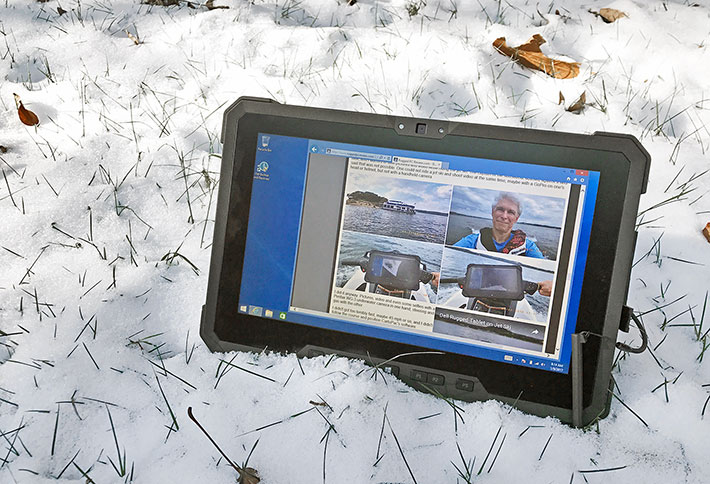
What it all means is that Dell decided to equip its rugged tablet with a sophisticated processor, but one frugal enough to offer remarkable battery life. That's important in a tablet. The flipside is that this type of chip cannot offer the kind of sustained maximum performance of a chip and device designed to handle a much higher thermal load.
Good performance and long battery life
The 10 hour-plus battery life of consumer tablets such as the iPad has spoiled customers. Most now expect full-shift battery life from their ruggedized Windows tablets as well. Microsoft Windows' steadily improving power conservation measures, Intel's impressive efforts in making their chips more power-efficient, better batteries, and tablet manufacturers' growing expertise combine to give modern Windows tablets more performance and longer battery life. Is the Latitude 12 Rugged Tablet one of them?
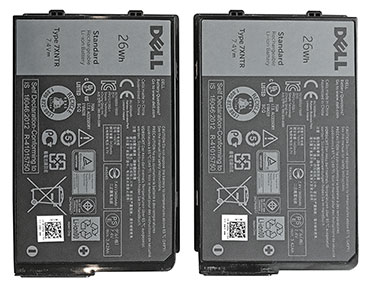 First a few words about the power situation of the Latitude 12 Rugged Tablet. The device has two battery bays, each accommodating a 2-cell 7.4 Volt/3,420mAH Lithium-Ion battery. That's a combined 52 watt-hours. The dual battery system means users can hot-swap one battery for a freshly-charged one at a time. Dell claims up to 12 hours of battery life from the two batteries. First a few words about the power situation of the Latitude 12 Rugged Tablet. The device has two battery bays, each accommodating a 2-cell 7.4 Volt/3,420mAH Lithium-Ion battery. That's a combined 52 watt-hours. The dual battery system means users can hot-swap one battery for a freshly-charged one at a time. Dell claims up to 12 hours of battery life from the two batteries.
52 watt-hours is only a bit less than the 56 watt-hours Dell's Latitude 12 Extreme convertible comes with, and that model comes with processor options that all have a much higher thermal design power than the CPU options of the tablet (15 watts versus 4.5 watts).
In our testing of the Dell 12 Rugged Extreme we measured a minimum power draw of 4.1 watts, good for an impressive theoretical 13.65 hours. How does the tablet compare to that? To find out we tested power draw with PassMark's BatMon utility.
|
Dell Rugged Tablet Power Draws (at idle)
|
|
Backlight level
|
Lowest (0%)
|
50%
|
Maximum (100%)
|
|
Power Saver
|
3.3 watts
|
3.7 watts
|
6.6 watts
|
|
Dell
|
3.3 watts
|
3.5 watts
|
6.7 watts
|
|
Max Performance
|
3.7 watts
|
4.3 watts
|
7.1 watts
|
With the Windows power settings to "Power Saver" and screen brightness at its dimmest, we saw a power draw as low as 3.3 watts, good for a theoretical 15.75 hours. With the backlight at 50%, we saw 3.7 watts, good for a theoretical 14.05 hours. And with the backlight all the way up, power draw rose to 6.6 watts, good for a theoretical 7.9 hours.
In the "Dell optimized" mode, we measured almost identical power draw as in Power Saver mode, so we recommend using the Dell setting.
With the Windows power settings to "Max Performance" and screen brightness at its dimmest, we saw a power draw as low as 3.7 watts, good for a theoretical 14.05 hours. With the backlight at 50%, we saw 4.3 watts, good for a theoretical 12.1 hours. And with the backlight all the way up, power draw rose to 7.1 watts, still good for a theoretical 7.3 hours.
Overall, we found Dell's rugged tablet to be quite power-efficient. The minimum draw of 3.3 watts is one of the lowest we have registered in years of testing, and Dell's 12-hour estimate seems achievable. That said, note that screen brightness significantly affects the tablet's battery life.
Security
For security, the Dell Latitude Tablet has FIPS 140-2 TPM 1.2 functionality to store secured information. Smart Card reader and optional fingerprint reader provide additional access security. There's a cable lock slot, some of the available processors support vPro, a set of Intel security and remote management technologies that offer multiple lines of built-in defenses, and there are also Dell's advanced security and data protection and encryption tools.
Dell also offers Dell Data Protection and Encryption, which is available in a Personal Edition for a locally managed solution or an Enterprise Edition for a centrally managed solution that scales to tens of thousands of protected endpoints. The idea here is to provide encryption, advanced authentication and integrated threat protection to keep data safe wherever it goes.
A look inside the Dell 12 Rugged Tablet
If you open a premium consumer tablet (which is generally next to impossible), what you find inside is a huge battery and a tiny circuitboard and very little else. That's because the guts of consumer tablets are hyper-miniaturized and very much closed systems. A rugged Windows tablet is very, very different. In essence, it's a full PC squeezed inside a slender box. That means plenty of miniaturization, too, but everything is still recognizable as PC components, with standard connectors, components and modules. And that's what you find inside of the Dell Rugged Tablet.
The other big problem makers of rugged Windows tablet face is that they also have to build this complex package so that dust and water won't get inside despite a whole complement of onboard PC standard ports, and so that things don't break or come loose when the device is dropped and rattled around. How did Dell go about making it all possible?
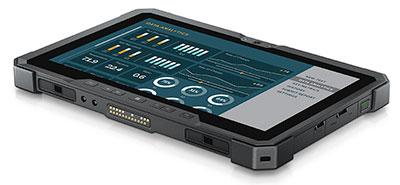 Well, they had a good base in the form of their existing Latitude 12 Rugged Extreme convertible notebook (see our full review), and that machine serves as the foundation for Dell's rugged tablet. Well, they had a good base in the form of their existing Latitude 12 Rugged Extreme convertible notebook (see our full review), and that machine serves as the foundation for Dell's rugged tablet.
In essence, Dell condensed the guts of their convertible into a pure tablet form factor, retaining the same 11.6-inch display size and much of the functionality, but paring 40% of the weight and updating underlying technologies in the process.
That's not to say that the tablet and the convertible use the same internal layout. Tablets and convertibles are inherently different, with convertibles being two-box designs and tablets all-in-ones.
Unlike most mobile Windows systems, the 12 Rugged Tablet doesn't have any removable doors on its backside to provide access to RAM memory and internal expansion slots. So if you want to replace memory or one of the PCIe modules, or if maintenance becomes necessary, you have to take the tablet apart.
That's not terribly difficult. Undo a couple of dozen small Philips screws and the halves easily come apart. There are three ribbon cables between the halves and those always have fragile connectors, so care is advised.

The seal between the back and the front part of the housing — both made of impact-resistant, flame-retardant, fiber-reinforced PC-GF50(40) polycarbonate — is a hard plastic lip on the backside that presses onto a thin black rubber o-ring seal sitting in a channel on the front side. The o-ring seal is long and complex but seems replaceable. What's interesting here is that the seal doesn't just go along the perimeter of the tablet. Instead, it weaves in and out, protecting the electronics inside, but leaving anything I/O-related outside.
 That's because it is quite difficult to properly seal standard PC ports and connectors. In most rugged devices those ports are not actually sealed to the inside. Instead, rubber plugs and hinged doors provide the protection. If one of them isn't closed properly, liquids can enter the inside of such devices. With Dell's design, it can't. That's because it is quite difficult to properly seal standard PC ports and connectors. In most rugged devices those ports are not actually sealed to the inside. Instead, rubber plugs and hinged doors provide the protection. If one of them isn't closed properly, liquids can enter the inside of such devices. With Dell's design, it can't.
In the Dell tablet there are protective plugs also, but if one of them is damaged or not closed properly, liquids may enter the I/O compartment they protect but they can't get into the interior of the tablet. Doing it this way is more complex, but potential damage is limited to an I/O module and not the entire tablet. And I say "potential" damage, because Dell actually applies what they call HZO liquid protection and describe as a "nanotechnology solution that inoculates electronic components from damage and failure."
An additional advantage of separating I/O modules from the motherboard is that this makes it much easier to upgrade and/or customize I/O. No need to redesign the motherboard.
Even though the internal layout of the Dell Rugged Tablet is complex, components such as WiFi (ours had an Intel Intel Dual Band Wireless AC 7260, Model 7260NGW half-card), mass storage (256GB Lite-On M.2 Solid State Disk), GPS (NEO-M8N), and other wireless modules, as well as the various antenna blocks, are easily accessible once the tablet has been opened.
The modularity, of course, is in Dell's DNA, the result of decades of offering an almost infinite number of permutations of options available right on Dell's website. So almost any feature for which there might be alternatives — or of which a customer might want more or less of — is not on the motherboard but designed as modules.
 One thing that's not immediately obvious is that the Dell Rugged Tablet does have a small fan. But weren't ultra-low voltage processors supposed to be able to operate without fans in Windows tablets? One thing that's not immediately obvious is that the Dell Rugged Tablet does have a small fan. But weren't ultra-low voltage processors supposed to be able to operate without fans in Windows tablets?
In the past, yes, under certain circumstances. That's because in the past there was no Intel "turbo" mode, the processor's ability to briefly run at higher (and sometimes much higher) than the nominal clock frequency, as long as temperatures didn't exceed certain levels.
Turbo mode is great, but it can turn into a problem in rugged machines. When a machine gets too hot out there in the desert and there is no active cooling, performance will drop, and can drop to unacceptable levels. That's why Dell chose to use a fan in the 12 Rugged Tablet. This way, performance will not drop, no matter what.
Overall, the interior of the Dell 12 Rugged Tablet is a complex, sophisticated affair that clearly shows Dell's experience in mobile computing technology. Components and modules are clearly marked and have their own 2D scan code. Wires that go from modules to their respective antennae located around the perimeter of the tablet for best reception are guided and held in place with little loops and guides.
Very good display
The Latitude 12 Rugged Tablet has a display that measures 11.6 inches diagonally. It offers 1366 x 768 pixel resolution, which makes for a fashionably wide 16:9 aspect ratio. That's a wider version of the 1024 x 768 XGA standard still very common in vertical market custom software. In essence, compared to the old XGA format, it's like getting another third of a screen added on the side. That resolution translates into about 135 dpi (dots per inch), not terribly sharp by today's leading smartphone and tablet standards, but still enough and also the same as the direct competition offers.

But, regardless of size or sharpness, providing the right display for a system that's being used outdoors is much more difficult than for one that's mostly used indoors in an office or at home. That's because we now have incredibly sharp, photorealistic-grade displays for indoor use, displays that one can't imagine getting much better. But outdoors is a totally different story.
That's because a) it's much brighter outdoors, with even the brightest display not being a match for sunlight, and b) because there are all sorts of reflections that can quickly make a display unreadable.
 With regard to LCD outdoor viewability, Dell has been a pioneer. As far back as 2007, Dell had laptop displays that had their screen cover optically bonded to the LCD, thus eliminating the reflections from the LCD surface, eliminating the need to AR-coat the bottom of the screen cover, and eliminating the air gap. With regard to LCD outdoor viewability, Dell has been a pioneer. As far back as 2007, Dell had laptop displays that had their screen cover optically bonded to the LCD, thus eliminating the reflections from the LCD surface, eliminating the need to AR-coat the bottom of the screen cover, and eliminating the air gap.
The methods Dell applied reduced overall reflectivity and resulted in a very good effective contrast ratio. At the time, we termed it "definitely readable in sunlight." That was rare back then.
Time doesn't stand still though, and good outdoor-viewable displays are now available from all of the major rugged laptop vendors. Some are offering very high screen brightness of up to 1,500 nits, and optical treatments are continually refined. Dell describes the 12 Rugged Extreme's "Direct-View" screen as "designed to reduce reflections, preserve contrast and conserve battery life."
In an article entitled "What Really Makes A Mobile Device Screen Readable Outdoors?" Dell Rugged Mobility Marketing Director Patrick Seidensticker reiterated Dell's thought process that led them to concentrate on reducing reflected light as opposed to using battery-draining super-bright backlights. That means reducing the number of layers as each surface reflects sunlight back at the user, or bonding layers together to eliminate surfaces. And it also means using anti-reflective (AR) and anti-glare (AG) coatings. These two measures combined make for impressive outdoor viewability even without a strong backlight.
How well did all this work in the 12 Rugged Tablet whose display, according to its owner's manual, has a maximum luminance of 730 nits? For illustration, the pictures below are a side-by-side comparison between the 11.6-inch Dell screen and that of an Apple iPad Air 2 we're using around the office for this and that.
Both screens can easily be viewed outdoors, with the Dell tablet somewhat brighter than the iPad, which is said to run at about 450 nits. The iPad's fully glossy display surface, however, reflects far more than the Dell's screen.
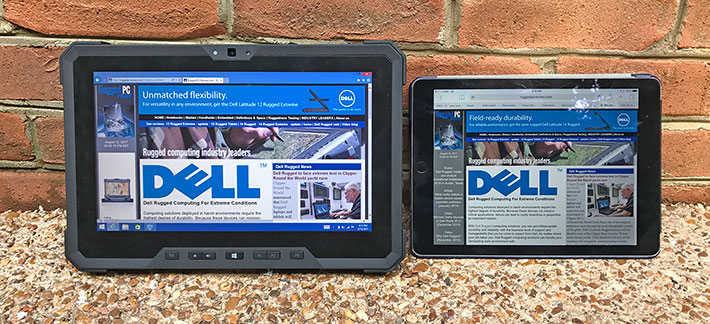
Both screens have almost perfect viewing angles horizontally as well as vertically, which is something we consider mandatory in a tablet. There are, however, differences. The Dell tablet doesn't lose brightness when viewed from extreme angles whereas the iPad appears noticeably darker. On the other hand, whites assume a bit of a yellow tinge on the Dell when viewed from extreme angles, whereas color remains unchanged on the iPad.

The picture below has both tablets sitting on the ground in direct afternoon sun. Here, the higher luminance of the Dell becomes again apparent. More importantly, though, is that the semi-matte Dell display mutes reflections as to make them almost irrelevant, whereas the iPad screen shows sharp blueish-purple and almost mirror-like reflections.
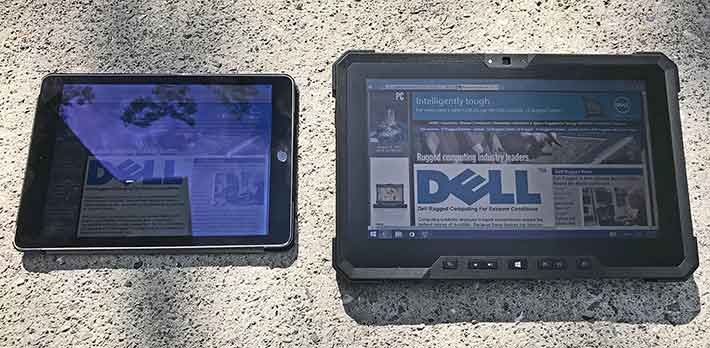
The final picture shows the 12 Rugged Tablet next to the iPad Air 2, with both displays off. It's instantly clear that although the Dell display is technically glossy just like the iPad's, Dell's DirectView controls reflections much better.
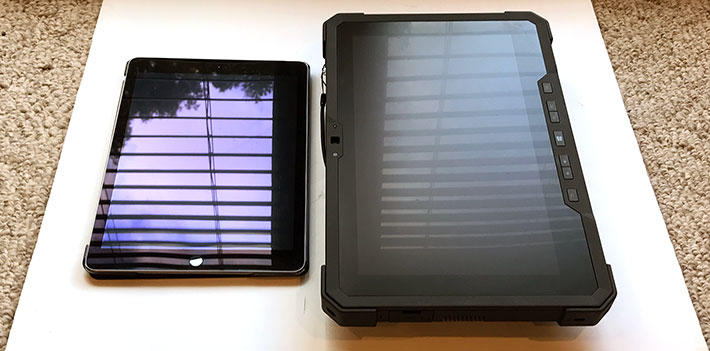
Cameras: good, but software please
The Dell Latitude 12 Tablet can be ordered with an optional integrated 2MP video front webcam with a hand-operated privacy shutter, and also an 8MP rear camera with LED flash that also has a manual privacy shutter. Our eval unit had both, but we did not go into detailed testing because the standard Windows Camera app is too limited to even judge the cameras' capabilities. Dell should install its own camera app that's optimized for the tablet cameras.
As is, the privacy shutters are clever low-tech solutions to guard against unauthorized snooping. You simply slide the camera window over so the lens is covered. We did take a few test stills that all came out in 1280 x 720 resolution of acceptable quality. Test video recorded in full 1920 x 1080 HD. The video was of good quality and the camera never sputtered, fell behind, or spent too much time hunting for focus. However, any user intending to use the cameras will have to resort to third party camera apps to really use the cameras.
Tough enough for the field
Ruggedness and durability are sore subjects with consumer tablets where almost universally style prevails over substance. Largely because of that, Dell points out that the 5-year total cost of ownership of a rugged solution is actually only half that of a consumer product.
 When Dell initially announced the Latitude 12 Rugged Tablet in summer 2015, Dell product manager Umang Patel said that while there were lots of options in the rugged tablet space, fully rugged tablets are heavy and expensive, and in the lower price range there wasn't much that offered the kind of features and performance that many prospective tablet users need. So Dell aimed between those two extremes. When Dell initially announced the Latitude 12 Rugged Tablet in summer 2015, Dell product manager Umang Patel said that while there were lots of options in the rugged tablet space, fully rugged tablets are heavy and expensive, and in the lower price range there wasn't much that offered the kind of features and performance that many prospective tablet users need. So Dell aimed between those two extremes.
As a result, while the Dell Rugged Tablet definitely looks and feels solid and trust-inspiring, it's not a tank. Dell simply and logically designed it to handle whatever conditions and eventualities would likely be encountered in the real world.
They viewed temperature a big issue, and so the Dell Rugged Tablet can operate within an extremely wide temperature range of -20° to 145° Fahrenheit (-29° to 63°Centigrade), which means practically anywhere. It certainly didn't mind being used outdoors on several Winter outings in the Great Smokey Mountains in Tennessee.
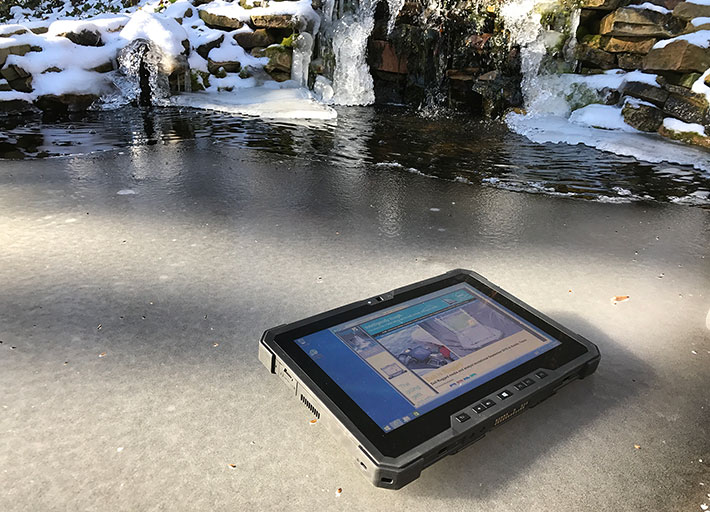
As for resistance to dust and liquids, the tablet carries an IP65 rating, where the "6" means the device is totally dust-proof, and the "5" that it can also handle low pressure water jets from all directions, albeit with "limited ingress permitted." Using the tablet in the rain is okay, spilling liquids on it is okay, but guard against submersion.
The images below were taken during a Dell media event late 2016 at Lake Travis outside of Austin, Texas. Dell Rugged Tablets with CartoPac GPS-based course tracking software were strapped onto jet skis and taken on some speedy, bumpy rides. No problem.
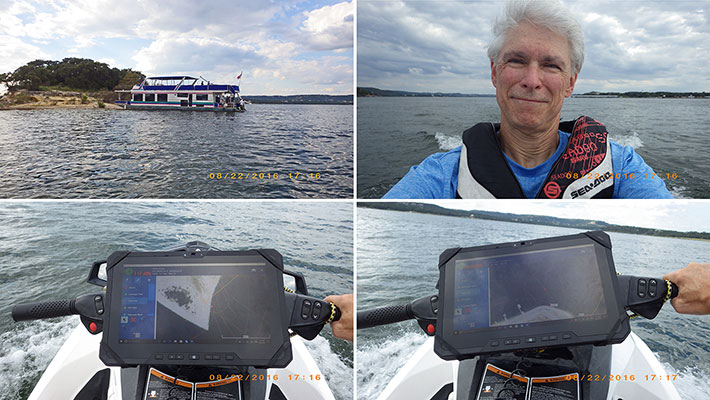
Drop tests were conducted in accordance with MIL-STD-810G, Method 516.6, Procedure IV procedures. Closed and not operating, the unit survived 26 drops from 48 inches. The maximum height tested while open and operating was 36 inches. That's also impressive, but we like to see the ability to survive 4-foot drops while open and operating, because that is the height at which a laptop might be held while in a standing position.
Dell says the device is also independently tested according to MIL-STD-810G procedures for transit drop, blowing rain, blowing dust and sand, vibration, functional shock, freeze/thaw cycles, and more.
Dell generally has ruggedness testing done by SGS US and SGD Taiwan, SGS being one of the world's leading inspection, verification, testing and certification companies. Additional testing was done by the Taiwan and China locations of UL, a global independent safety science company. The images below were taken at a tour of Dell's own ruggedness testing facilities in Austin, Texas.
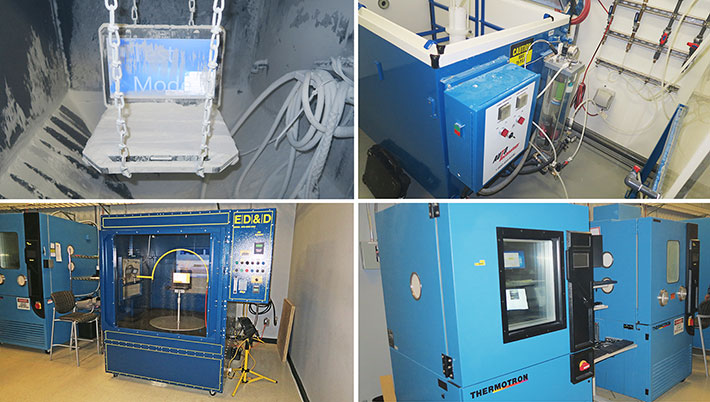
For use in hazardous locations, ATEX and C1D2 certification is available. These are becoming more and more important, and they are a prerequisite for deployment in industries such as oil, gas, and petrochemical manufacturing, and many others where ignitable gases or vapor may be present.
Overall, the Dell Rugged Tablet is just that, rugged. It's very well built, very sturdy, rubber bumpers provide good protection, and ports are well sealed with both plugs and sealing inside. That said, the emphasis here is on an intelligent balance of toughness and ease-of-use, not on heavy, vault-like invulnerability.
Summary: The Dell Latitude 12 Rugged Tablet
The Dell Latitude 12 Rugged Tablet is for those who a) want an exceptionally well designed and executed tablet for tough jobs, b) want a pure tablet, but one with a perfectly matched optional detachable keyboard, and c) prefer one-stop shopping with a world-leading provider of commercial PCs with large scale production experience and extensive support.
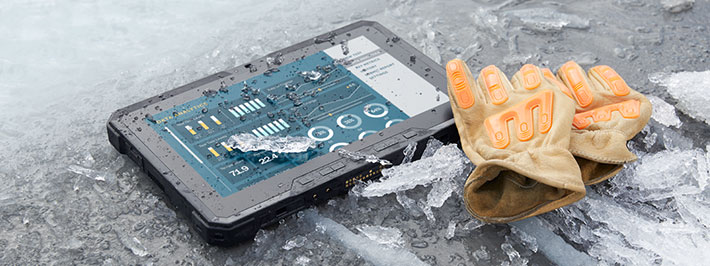
Its 11.6-inch 1366 x 766 pixel display is bright and offers superior reflection control, making it easy to use outdoors and even in bright sunlight. It also provides effortless multi-touch capability that works even with gloves on. The included narrow-tip capacitive stylus works well, and there is also an active pen option.
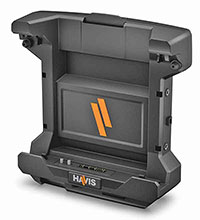 The Dell Rugged Tablet covers connectivity basics (USB, Micro HDMI, Micro SD card, Micro serial, audio) and can also be configured with fingerprint and standard or contactless smart card readers. Additional connectivity as well as barcode and magnetic stripe reading is available via bolt-on modules. For on-the-road use, there's a Havis vehicle dock with additional connectivity, for the office a handy desk dock with dual battery charging.
The Dell Rugged Tablet covers connectivity basics (USB, Micro HDMI, Micro SD card, Micro serial, audio) and can also be configured with fingerprint and standard or contactless smart card readers. Additional connectivity as well as barcode and magnetic stripe reading is available via bolt-on modules. For on-the-road use, there's a Havis vehicle dock with additional connectivity, for the office a handy desk dock with dual battery charging.
Performance is provided by a choice of super-efficient Intel 5th generation Core M processors that combine very good peak performance with superior power management, making full shift operation without battery recharging possible (dual batteries provide hot-swapping).
As the name implies, this is a rugged device designed to hold up to harsh conditions in the field. All ports have protective doors, there are protective bumpers, the construction is very solid, and Dell provides comprehensive ruggedness testing data.
Overall, in our long-term testing, the Dell Latitude 12 Rugged Tablet never let us down and convinced us as an elegant, very competent tablet solution with enough performance and connectivity, very good expandability, and an excellent optional detachable keyboard that we highly recommend. – Conrad H. Blickenstorfer, August 2017
|
Dell Latitude 12 Rugged Tablet Specifications
|
| Added/changed |
Added 07/2015, full long-term review 08/2017
|
| Type
|
Rugged tablet
|
| CPU
|
Intel Core M-5Y71 (1.20/2.90GHz, 4MB cache, 4.5 watts, 2 cores/4 threads)
Intel Core M-5Y10c (0.80/2.00GHz, 4MB cache, 15 watts, 2 cores/4 threads)
|
| OS
|
Windows 10 Pro (64-bit) or Windows 7 Pro (64-bit)
|
| Graphics
|
Intel HD Graphics 5300 (300/900MHz)
|
| Memory
|
Up to 8GB 1600MHz LPDDR3
|
| Display
|
"Direct-View" outdoor-readable, LED backlight, Gorilla Glass 3 protective front glass, 730 nits, viewing angles 120° horizontal, 100° vertical
|
| Display size and resolution
|
11.6-inch/1366 x 768 pixel 16:9
|
| Digitizer/Pens
|
Capacitive multi-touch, glove-capable; optional active pen
|
| Keyboard
|
Onscreen, optional external
|
| Storage
|
128GB, 256GB or 512GB mSATA Solid State Drive, optional 256GB mSATA OPAL encrypted SSD
|
| Multimedia Pocket
|
None
|
| Slots
|
1 x microSD card
|
| Housing
|
Impact-resistant, flame-retardant, fiber-reinforced PC-GF50(40) polycarbonate
|
| Temperature
|
-20° to 145°F (-29° to 63°C)
|
| Humidity
|
MIL-STD-810G, Method 507.5, Procedure II, 10-90% noncondensing
|
| Vehicle vibration
|
ASTM D4169-04 (99), Schedule E, Truck Assurance Level II
|
| Salt Fog
|
MIL-STD-810G, Method 509.5, Procedure I (optional)
|
| Enclosure Class
|
IP65
|
| Altitude
|
MIL-STD-810G, Method 500.5, Procedure II (15,000 feet operating)
|
| Shock: Transit Drop
|
MIL-STD-810G transit drop (72/60/48"); 3-foot operating drop
|
| HazLoc
|
Optional: ANSI/ISA.12.12.01 certification capable (Class I, Division 2, Groups A, B, C,D) CAN/CSA C22.2 No. 213-M1987 Class I, Division 2
|
| Certifications
|
See test report here (PDF).
|
| Size (inches)
|
12.3 x 8.0 x 0.96 inches (312 x 203 x 24 mm)
|
| Weight
|
Starting at 3.6 lbs. (1.6 kg) with single 2-cell battery; test unit was 4.4 lbs. with two batteries and port expansion module.
|
| Power
|
2-cell 26Wh Li-Ion, optional second 2-cell 26Wh Li-Ion ("up to 12 hrs with two 2-cell batteries")
|
| Cameras
|
Optional: FHD video front webcam with privacy shutter, 8mp rear camera with privacy shutter and LED flash
|
| Security
|
Optional: Fingerprint reader, Contactless Smart Card reader
|
| Communication
|
Intel Dual Band Wireless-AC 7265 with Bluetooth 4.0 LE; opt. Dell Wireless 5808E Gobi 5000 4G LTE, opt. u-blox NEO-M8 GPS
|
| Interface
|
1 x USB 3.0, 1 x micro RS232, 1 x micro HDMI, audio in/out, pogo-pin dock/kbd, pogo-pin modular expansion (back)
|
| Price
|
Starting at US$1,849 (Dell website, 08/08/2017)
|
| Website
|
Dell Latitude 12 Rugged Tablet web page
|
| Ruggedness results
|
 Dell Latitude 12 Rugged Tablet environmental testing report Dell Latitude 12 Rugged Tablet environmental testing report
|
| Spec sheet
|
 Dell Latitude 12 Rugged Tablet brochure Dell Latitude 12 Rugged Tablet brochure
|
| Warranty
|
Standard 3-year next business day on-site service after remote diagnosis. Optional 3-year premium support with 24x7 global availability.
|
|
|



